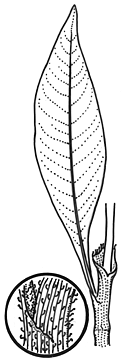Persicaria elatior (R.Br.) Soják APNI* Synonyms: Polygonum elatius R.Br. APNI*

Description: Erect herb to 90 cm high, stalked glandular hairs present on most parts, occasionally sessile glands present too.
Leaves narrow-ovate, 3–11 cm long, 10–30 mm wide, with sessile glands and scattered stalked glandular hairs on both surfaces, simple hairs on margins; petiole 5–15 mm long; ocrea with glandular hairs c. 0.5 mm long on upper margin.
Spikes elongate-cylindrical, dense, 1.8–5 cm long, 5–7 mm diam. Perianth segments 3.0–3.8 mm long, pink.
Achene lenticular, 2.1–2.5 mm long, c. 2.5 mm diam., black.
Distribution and occurrence: Rare; very scattered occurrences along coastal NSW and in SE Qld. In damp places, usually on the margin of standing water.
NSW subdivisions: NC, CC, SC
Other Australian states: Qld
Threatened species: NSW BCA: Vulnerable; Commonwealth EPBC: Vulnerable
It could be confused with P. lapathifolia. It consistently differs from P. lapathifolia in having abundant stalked glandular hairs on stems, inflorescence branches and bracts, ocreas and leaves, not just scattered on the inflorescence branches as in P. lapathifolia.
Text by K. L. Wilson (1990); edited KL Wilson (Jan 2014)
Taxon concept: Flora of NSW 1 (1990)
APNI* Provides a link to the Australian Plant Name Index (hosted by the Australian National Botanic Gardens) for comprehensive bibliographic data
***The AVH map option provides a detailed interactive Australia wide distribution map drawn from collections held by all major Australian herbaria participating in the Australian Virtual Herbarium project.
|


